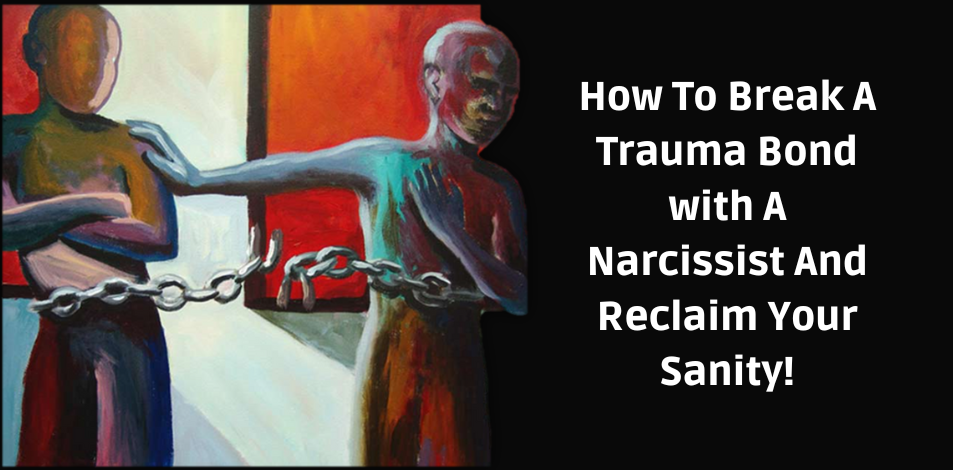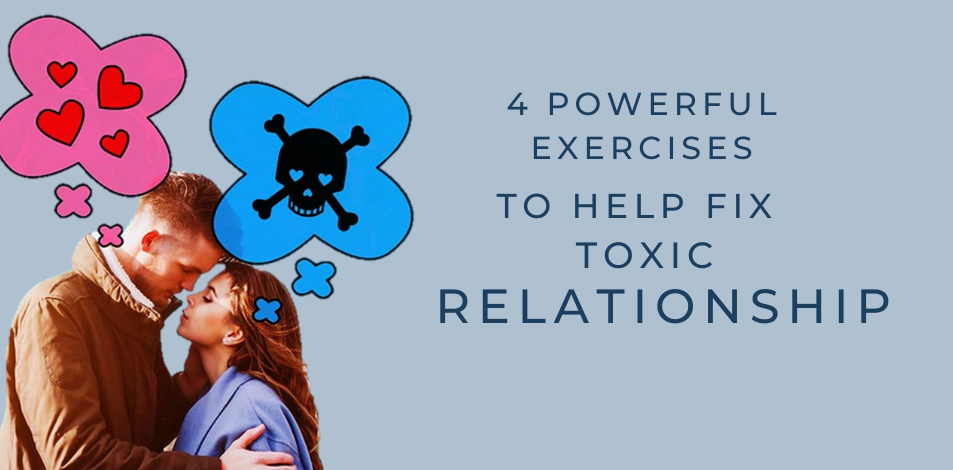

If you are trapped in an abusive cycle and wondering how to break your trauma bond with a narcissist, you have come to the right place!
Are you traumatically related to a narcissist? Breaking a traumatic bond with a narcissist can be an incredibly difficult and complex process.
A trauma bond is a strong emotional bond that forms between an individual and their abuser, often resulting from prolonged exposure to manipulation, control, and abuse.
Narcissists, with their self-centered and exploitative tendencies, can be especially adept at creating and perpetuating trauma bonds.
However, through knowledge, self-awareness, and strategic steps, it is possible to break free and embark on a journey toward healing and reclaiming your life.
In this article, we will explore a comprehensive guide to breaking a traumatic bond with a narcissist, offering insights, strategies, and support for individuals on this transformative path.
What is narcissism?
Breaking the Chains: How to Break the Trauma Bond with a Narcissist and Reclaim Your Sanity!
Narcissism is a complex personality trait that involves an excessive preoccupation with oneself, an inflated sense of self-importance, and a lack of empathy for others.
Individuals with narcissistic tendencies often display a heightened sense of self, a constant need for admiration and validation, and a tendency to exploit and manipulate others to meet their own needs.
Narcissism can manifest in different degrees, ranging from narcissistic traits to narcissistic personality disorder (NPD), which is a more severe and widespread form.
While it is important to note that not all individuals with narcissistic traits have NPD, underlying characteristics of narcissism can greatly affect relationships, work environments, and general well-being.
One of the hallmarks of narcissism is an exaggerated sense of self-importance. Narcissists often believe that they are special, unique, and entitled to privileges and admiration from others.
They may constantly seek attention, praise, and validation to maintain their inflated self-image. This need for admiration can lead to manipulative behaviors, as narcissists take advantage of others to boost their egos and fulfill their desires.
The other main characteristic of narcissism is a lack of empathy. Narcissists struggle to understand or relate to the feelings and experiences of others.
They tend to prioritize their own needs and desires above everyone else’s and often disregard the emotions and well-being of those around them.
This lack of empathy can lead to a pattern of people using and neglecting, in which narcissists view others as mere extensions of themselves or as sources of gratification.
Narcissists also tend to engage in grandiose fantasies and exaggerated self-representations. They may create a false image of superiority, success, or talent to gain admiration and validation.
This inflated self-image can lead to disregard for rules, boundaries, and moral considerations, as narcissists believe they are above these limitations.
Narcissists in relationships often display controlling and manipulative behaviors. They may engage in gaslighting, where they distort the truth and manipulate the perception of others to maintain control and power.
Narcissists may exploit others’ weaknesses, undermine their self-esteem, and engage in emotional manipulation to assert dominance and meet their own needs.
Narcissism’s influence extends beyond one-on-one relationships. In work settings, narcissists may display a need for constant recognition and validation, often at the expense of others.
They may prioritize their success and advancement, neglecting teamwork and collaboration. Their excessive self-focus can create a toxic atmosphere and hinder collaboration and productivity.
It is essential to understand that narcissism is a complex psychological trait that can stem from various factors, including childhood experiences, genetic predisposition, or a combination of both.
While individuals with narcissistic traits may display challenging behaviors, it is crucial to approach the subject with empathy and seek professional guidance when dealing with severe cases of narcissism or abuse.
Fine, narcissism is characterized by excessive preoccupation with oneself, an inflated sense of self-importance, and a lack of empathy for others.
The impact of narcissism can be far-reaching, affecting relationships, work environments, and general well-being.
Trauma bonding in a narcissistic relationship: What is the trauma bond?
Breaking the Chains: How to Break the Trauma Bond with a Narcissist and Reclaim Your Sanity!
Before we get to how to break a trauma bond with a narcissist, let’s first understand the dynamics of narcissistic bonding and trauma.
A trauma bond is a strong emotional attachment that develops between an individual and their abuser. It is characterized by a mixture of positive and negative experiences, intermittent reinforcement, feelings of dependency, and power imbalance.
Narcissists use various tactics such as love bombing, gaslighting, and devaluation to keep their victims trapped in the trauma bond. Understanding these dynamics can help you gain clarity about the situation.
How do you break a trauma bond with a narcissist? The shocking link usually follows a cycle of idealization, devaluation, and disregard. Recognizing this pattern can help you break free from the cycle and take back control of your life.
How do you break a trauma bond with a narcissist? If you have associated trauma with a narcissist, identifying the trauma bond is critical to recognizing unhealthy dynamics in the connection.
This realization is the first step towards liberation from the traumatic bond with the narcissist.
Read : Love Bombing As A Narcissistic Attachment Style
How do you break a trauma bond with a narcissist?
Here are some strategic tips that can help you break the trauma bond with a narcissist:
- Embrace self-compassion
Traumatic bonding in a narcissistic relationship is a very difficult and emotionally stressful experience.
Acknowledge that your experience was real and that you are not responsible for the shock link. Practice self-compassion and be kind to yourself as you begin the healing process.
- Practice Self-Empowerment:
To break a traumatic bond with a narcissist, engage in activities that help you regain a sense of personal power and agency. Set small goals and achieve them to rebuild your confidence. - Practice self-forgiveness.
Experiencing narcissist-related trauma can lead to feelings of guilt and shame, and you must let go of it. Let go of any self-blame or guilt for being in the traumatic bond.
Understand that you have been manipulated and deceived by the narcissist, and that self-forgiveness is a critical step in the healing journey.
- Cultivate self-confidence and intuition
One of the most damaging effects of bond trauma is the erosion of self-confidence. Start rebuilding your self-confidence by acknowledging and respecting your thoughts, feelings, and instincts.
Practice listening to your intuition and making choices that align with your inner wisdom. Over time, you will regain your confidence in your ability to make decisions that are in your best interests.
- Understand the impact of trauma
Being exposed to narcissist-related trauma for a prolonged period is bound to have negative emotional, mental, and physical effects.
Educate yourself about the negative effects of narcissistic manipulation, abuse, and trauma. Know that your feelings and reactions are valid for the abuse you experienced.
- Diary and Expression:
Traumatic bonding in a narcissistic relationship can leave you feeling overwhelmed. Use journaling as a therapeutic tool to express your feelings, reflect on your experiences, and gain insight into the healing process. - Request validation from reliable sources
To break a trauma bond with a narcissist, reach out to supportive friends, family members, or professionals who can validate your experiences and provide a safe space for you to express and process your feelings. - Educate yourself about narcissistic abuse
Relationship trauma in a narcissistic relationship is a deeply abusive relationship.
Arm yourself with knowledge about narcissistic personality disorder, manipulative tactics, and strategies narcissists use to gain insight. This knowledge will empower you during the recovery process.
- Put in place physical and emotional safety measures
When you are trying to break out of a traumatic bond with a narcissist, make sure of your physical safety first. You can change your locks to secure your home and, if necessary, seek legal protection. Emotionally, set boundaries to protect yourself from further harm. - Identify support networks
To break the trauma bond with a narcissist, build a support system of trusted friends, family, or support groups who can offer encouragement, guidance, and help along your journey. - Create a self-care routine
Trauma associated with a narcissist can make you so emotionally stressed that you can ignore your appearance as well as your hygiene.
How do you break a trauma bond with a narcissist? Start by bringing your attention back to yourself.
Prioritize self-care activities that enhance your well-being and recovery. Engage in practices such as exercise, meditation, journaling, and hobbies that bring you joy.
- Use professional resources
Traumatic bonding in a narcissistic relationship is emotionally and mentally harmful. Consider seeking treatment or counseling from professionals with experience in narcissistic abuse.
They can help you navigate the complexities of bond trauma and provide tools for healing.
- Create no-contact or low-contact boundaries
How do you break a traumatic bond with a narcissist if you are still in contact with them? You can not! One of the most effective ways to break the trauma bond with a narcissist is to set strict boundaries.
No contact involves completely severing all contact with the narcissist, while low contact involves reducing contact with only the essentials. Decide which approach is best for your situation and stick to it consistently.
- Detoxify your environment
To successfully end a traumatic relationship with a narcissist, remove reminders of your relationship from your living space.
Get rid of things that trigger painful memories or associations. Rearrange your surroundings to create a fresh, positive atmosphere that supports the healing process.
- Apply safeguards related to technology and social media
To break the trauma bond with a narcissist, block the narcissist on all social media platforms and make sure your online presence is private.
Restrict their ability to contact you digitally. Consider changing phone numbers or email addresses if needed to create a clean break.
- Dealing with the urge to break no contact
Trauma associated with the narcissist for a long time can make you emotionally dependent on the narcissist.
Breaking the trauma bond can trigger intense feelings and a strong desire to reconnect with the narcissist.
In these moments, remind yourself of the pain and toxicity of the relationship. Connect with your support system for encouragement and distraction to resist the urge.
- Engage in self-reflection and self-awareness
How do you break a trauma bond with a narcissist? Think about the impact of bond trauma on your self-esteem and self-esteem. Challenge any negative beliefs or self-blame that may have arisen as a result of the narcissistic abuse.
Practice self-compassion and self-acceptance as you embark on a journey of rebuilding. Engage regularly in self-reflection to deepen your understanding of yourself, your needs, and your limitations.
Journaling, meditating, or finding solitude in nature can provide opportunities for reflection and self-discovery. Use these practices to gain insight into the patterns, triggers, and areas of personal growth.
- Challenging distorted beliefs
To break free from your traumatic bond with a narcissist, identify and challenge the distorted beliefs the narcissist has instilled in you. Replace them with thoughts of empowerment and affirmation.
Identify and challenge any distorted thinking patterns that the narcissist may have been reinforcing. Replace negative self-beliefs with realistic, positive affirmations.
- Practice Compassionate Self-Talk:
How do you break a trauma bond with a narcissist? Replace self-critical thoughts with compassionate self-talk. Remind yourself that you deserve love, respect, and healing. Offer yourself kindness and understanding during difficult times. - Rediscover your passion:
Trauma associated with a narcissist can separate you from your hobbies, passions, and interests. Reconnect with activities and hobbies that bring you joy and fulfillment.
How do you break a trauma bond with a narcissist? Rediscovering your passion can help rebuild a sense of identity that may have been eroded during the traumatic bond and help you break through chains.
- Educate yourself about healthy relationships.
To understand the interconnectedness of trauma in a narcissistic relationship, you must learn about healthy relationship dynamics, communication skills, and red flags to avoid falling into similar patterns in the future.
Knowledge is power when it comes to protecting yourself from further harm.
- Explore therapies
To break the traumatic bond with a narcissist, consider different therapies, such as:
Cognitive behavioral therapy (CBT)
Dialectical behavior therapy (DBT)
trauma-focused therapy,
For the treatment of deep-seated wounds caused by traumatic bonding. Professional guidance can help you navigate the healing process and build resilience.
Trauma-focused therapy can be very helpful in healing the deep emotional wounds caused by narcissistic abuse.
Therapies such as cognitive behavioral therapy (CBT), dialectical behavior therapy (DBT), or EMDR (eye movement desensitization and reprocessing) can help address trauma, reframe negative beliefs, and develop effective coping strategies.
- Explore alternative therapies
In addition to therapy, explore alternative healing methods that resonate with you. This may include practices such as energy healing, acupuncture, aromatherapy, or bodywork.
These techniques can help restore balance to your mind, body, and spirit and support the overall healing process.
- Create a Support Network of Professionals:
Find therapists, counselors, or coaches who specialize in recovering from narcissistic abuse. These professionals can provide expert guidance and support tailored to your needs. - Engage in self-discovery:
Narcissistic attachment and trauma can take up a lot of space in your life. Take the time to explore your values, needs, and desires outside of the narcissist’s influence. Reconnect with who you are as an individual and rediscover your authentic self.
Use this experience as an opportunity for self-discovery and expansion. Explore your interests, values, and passions to reconnect with yourself on a deeper level and build a fulfilling life beyond the bond of trauma.
Set goals, pursue new interests, acquire new skills, and invest in activities that contribute to your personal and professional growth.
- Practice mindfulness and grounding techniques:
How do you break a trauma bond with a narcissist? Develop mindfulness to stay present at the moment and manage overwhelming emotions.
Grounding techniques, such as deep breathing or focusing on your senses, can help you regain a sense of stability and calm during difficult times.
- Develop a safety plan for potential triggers:
Your ordeals with narcissistic bonding and trauma can be very painful and keep coming back as flashbacks when you turn them on.
You can identify situations, places, or people that may trigger memories or feelings associated with the trauma bond. Create a plan to reduce exposure to these triggers and develop coping strategies to navigate them if they cannot be completely avoided.
- Engage in self-soothing techniques
During moments of emotional turmoil or triggering situations, engage in self-calming techniques to calm your nervous system and provide relief.
Deep breathing exercises, mindfulness practices, or engaging in activities that bring you joy and relaxation can help regulate your emotions and provide a sense of security.
- Explore Creative Outlets:
If you are a victim of narcissistic bonding and trauma, you may feel restricted and unable to express yourself.
So, how do you break a trauma bond with a narcissist? Engaging in creative activities, such as art, writing, music, or dance, can provide a therapeutic outlet for expressing and processing emotions.
Creativity allows you to tap into your inner strength and use it as a tool for healing and self-expression.
- Establish an affirmation practice:
Your experience with narcissistic bonding and trauma can have a profound effect on your sense of self.
Counteract the negative self-talk and self-doubt the narcissist instills by practicing self-affirmations regularly. Remind yourself of your worth, strengths, and resilience.
Read 8 Contrasting Signs of a Destroyed Narcissist and How to Protect Yourself From One
- Surround yourself with positive influences.
A narcissist can make you hopeless and pessimistic about your life and future. So, how do you break a trauma bond with a narcissist? Find positive and supportive people who validate and validate your experiences.
Surrounding yourself with healthy relationships can help you rebuild trust and boost your sense of self-worth.
- Practice Self-Affirmation and Boundary Setting:
Dealing with narcissistic bonding and trauma can leave you feeling vulnerable and vulnerable. Learn to firmly communicate your needs, wants, and limitations.
Practice saying “no” when necessary and prioritizing your well-being over meeting the demands of others.
- Engage in assertiveness training:
Consider participating in training programs or workshops to learn effective communication techniques, develop self-confidence, and strengthen your ability to assert your needs. - Seek professional legal advice if necessary:
If you are dealing with legal matters such as divorce, child custody, or restraining orders, consult with a qualified attorney who specializes in dealing with narcissistic abuse cases. - Engage in shock-informed bodywork:
Find out how the body works that are affected by trauma such as massage, yoga, or acupuncture. These practices can help release tension and trauma in the body, and promote feelings of relaxation and healing. - Validate your emotions and experiences
How do you break a trauma bond with a narcissist? Acknowledging and validating the range of feelings you may feel after breaking a traumatic bond with a narcissist.
Understand that it is normal to feel a mixture of anger, sadness, confusion, and even a sense of loss. Give yourself permission to feel and process those feelings without judgment.
- Engage in healing your inner child
Narcissistic abuse often leaves deep wounds from childhood that were reactivated. Engage in the child’s inner healing exercises to address and heal these wounds.
Connect with the inner child in you, offer love and support, and work to compensate yourself with care and compassion.
- Establish healthy relationships and build trust
Building new healthy relationships can be challenging after experiencing a trauma bond. Start by surrounding yourself with trustworthy, supportive individuals who genuinely care about your well-being.
Engage in open and honest communication, and allow relationships to develop naturally over time. Gradually, as you experience consistent support and care, you can begin to rebuild trust in others.
- Take back your power
During a traumatic bond, your strength may be undermined or taken away. How do you break a trauma bond with a narcissist? Reclaim it by taking steps to take back control of your life.
Set and pursue goals that align with your values and aspirations. Make decisions that reflect your true self and prioritize your needs and wants.
- Redefine your values and priorities
Take the time to reassess your values and priorities in life. Consider what matters to you and what brings you joy and fulfillment. Take this opportunity to redefine your life purpose and align your actions with your new understanding of yourself. - Set new, healthy relationship boundaries
As you rebuild your life, set clear, healthy boundaries in all of your relationships. Communicate your needs, expectations, and limitations to others.
Surround yourself with people who respect and respect your boundaries, and distance yourself from those who constantly ignore them.
- Practice assertive communication
Develop and practice assertive communication skills to express your thoughts, feelings, and needs with confidence and respect. This enables you to stand up for yourself, create healthy boundaries, and foster open and honest relationships with others. - Be open to lifelong learning
Commitment to continuous personal growth and learning. Participate in self-development books, workshops, or courses that help you understand yourself more, build resilience, and develop healthy relationship skills.
Adopt a growth and continuous improvement mindset.
- Practice gratitude and positivity
Develop an attitude of gratitude and shift your focus to the positive side of your life. Do regular gratitude exercises, in which you reflect on the blessings, progress, and supportive relationships in your life and express your appreciation for them.
This shift in perspective can enhance your overall well-being and resilience.
- Embrace a future full of authentic connections
How do you break a trauma bond with a narcissist? Go through! As you continue to recover, open up to the possibility of real, healthy relationships. Surround yourself with people who genuinely value and support you.
Embrace relationships based on mutual respect, trust, and reciprocity, allowing yourself to experience the joy of true connection.
- Recognizing Milestones and Achievements:
Acknowledge every milestone and accomplishment on your healing journey. Whether it’s breaking a harmful pattern, asserting boundaries, or making progress in therapy, take the time to acknowledge your growth and give yourself credit. - Celebrate your progress:
How do you break a trauma bond with a narcissist? Realize your strength and resilience in breaking free from the bond of trauma, and take pride in your growth.
Read : The Dark Truth: What Lies Beneath The Mask Of A Narcissist
The key to your freedom is in your hands
Breaking the traumatic bond with a narcissist is a difficult but essential step toward reclaiming your life and well-being. It requires courage, self-reflection, and support from trusted individuals.
So, how do you break a trauma bond with a narcissist?
By understanding the dynamics of the trauma bond, validating your experiences, creating a safety plan, detaching from the narcissist, and rebuilding your self-esteem, you can break free from the shackles of the trauma bond and move toward a healthier, happier future.
Remember, healing takes time, but with dedication and self-compassion, you can emerge stronger and more resilient than ever before.
Breaking a traumatic bond with a narcissist is a difficult and brave process. Give yourself the time, patience, and compassion you deserve.
By taking intentional steps toward healing, rediscovering your authentic self, and building a life of empowerment and authenticity, you can restore your happiness and create a brighter future.
Now that you know all about narcissism and how to break your trauma bond with a narcissist, please consider taking a moment to share your thoughts by leaving a comment below.
Also, don’t forget to share this article on Narcissistic Bonding and Trauma with anyone who might find it helpful!




